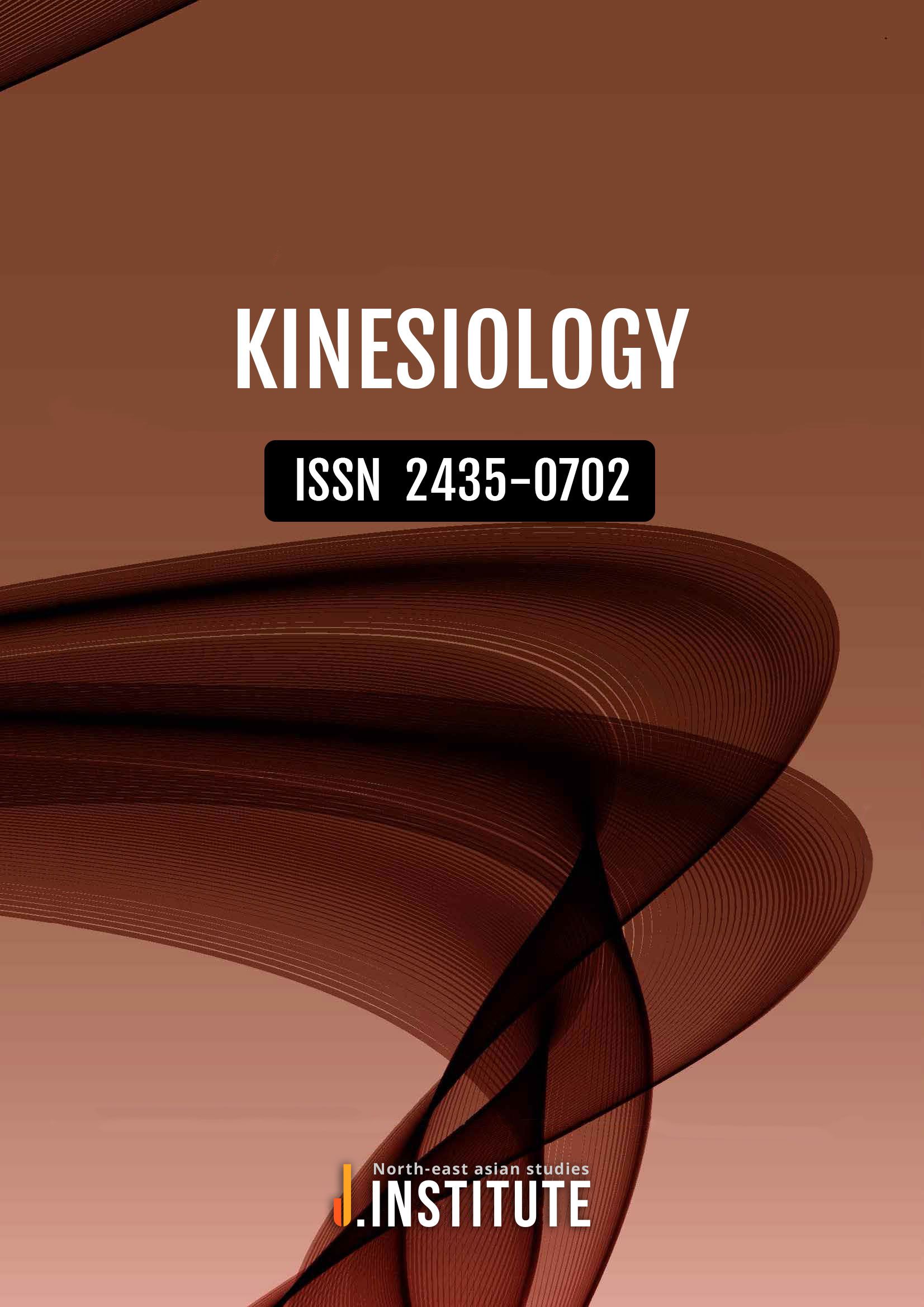- All
- Vol.1 (No.1) 2016
- Vol.1 (No.2) 2016
- Vol.2 (No.1) 2017
- Vol.2 (No.2) 2017
- Vol.3 (No.1) 2018
- Vol.3 (No.2) 2018
- Vol.4 (No.1) 2019
- Vol.4 (No.2) 2019
- Vol.5 (No.1) 2020
- Vol.5 (No.2) 2020
- Vol.6 (No.1) 2021
- Vol.6 (No.2) 2021
- Vol.6 (No.3) 2021
- Vol.6 (No.4) 2021
- Vol.7 (No.1) 2022
- Vol.7 (No.2) 2022
- Vol.8 (No.0) 2023
-
Purpose: The purpose of this study is to investigate the effects of home training(HT) and gym train-ing(GT) on body composition and basic physical fitness in female college students. Method: In this study, 39 female first-year physical education students enrolled in K University in D city were selected as the subjects of the home training group(HT, n=15), gym training group(GT, n=12), and control group(Con, n=12). The subjects were fully informed of the purpose of the study and gave their vol-untary consent to participate in the study. Body composition was measured by Weight, Body Mass Index, Percent Body Fat, Body Fat Mass, Lean Body Mass, and Skeletal Muscle Mass. Physical fitness was meas-ured by grip strength, sit-ups, vertical jump, sitting trunk flexion, and standing on one leg with eyes closed. The exercise program consisted of a warm-up, main exercises(upper body, core, and lower body), and a cool-down, with the core exercises being the same for both programs. Data processing for this study was performed using the SPSS 27.0 statistical program to calculate the mean and standard deviation for each measure, and a two-way analysis of variance with repeated measures was performed to examine the effect of each item by group and time of measurement. If the interaction was significant, a paired samples t-test was performed, and a one-way analysis of variance was performed to analyze the difference in the mean of the dependent variable between groups at the same time point. Statistical significance was considered at p<.05 for all measures. Results: The main effects of body composition period were significant(p<.05) for body weight, LBM, and skeletal muscle mass, with no significant group interaction. Post hoc tests of the main effect of time revealed a significant main effect for body weight, but no significant post hoc differences from pre to post for any group. The main effects of physical fitness period were significant(p<.01) for the vertical jump, grip strength(left), grip strength(right), sit-ups, and standing on one leg with eyes closed, but the group interaction was not significant for all items. Post hoc tests of the main effect of time showed that the HT group significantly(p<.05) increased from pre to post in the standing vertical jump, grip strength(left) was signifi-cantly(p<.05) lower in the GT group from pre to post, and sit-ups were significantly(p<.01) higher in the HT group from pre to post. Conclusion: Gathering the results above, the home training group showed an increase in sit-ups and vertical jump in place from the pre- to post-training, it is possible to see some effectiveness of the training, but it is difficult to clear conclusions. Therefore, further research is needed to determine the effectiveness of home training.Keyword:Female College Students, Home Training, Gym Training, Body Composition, Physical Fitness
-
Purpose: The purpose of this study was to review the alterations in muscle fibers in Parkinson's dis-ease(PD). The following were our review questions. (1)How has research on type I myofiber grouping in PD developed over time? (2)What kinds of muscles are affected in which patients? (3)What are some possible pathophysiology and mechanisms? Does type I myofiber grouping in PD differ from primary sarcopenia that occurs with aging? (4)What are the clinical implications and possible therapeutic approaches for type I myofiber grouping in PD?. Method: To investigate the questions, we used combinations of keywords such as “Parkinson”, “skeletal muscle”, “myofiber type”, “fast twitch”, “slow twitch”, “myofiber grouping”, and “motor unit” in PubMed and Google Scholar. Articles on PD patients and normal elderlies that dealt with type I myofiber grouping and motor unit alterations were included. References in the included articles were also considered. Results: Research over the past five decades has identified various motor abnormalities and myofiber alterations in PD patients, including the hypertrophy of slow-twitch type I myofibers and atrophy of fast-twitch type II myofibers across different muscles. One important finding is that Type I myofiber grouping, which is common in aging, is more severe in PD, which could be due to the selective activation of low-threshold motor units and could be also linked to abnormal alpha-synuclein aggregation, a factor associ-ated with PD. Conclusion: Research suggests that type I myofiber grouping in muscles, not just dopaminergic cell damage in the substantia nigra, could influence motor symptoms of PD, indicating that alternative treat-ments beyond dopaminergic drugs, such as high-intensity exercise, might be beneficial. However, given the limitations in these studies, such as small participant numbers and the complexity of PD pathophysiology, future research is needed to fully understand the phenomena in different PD subtypes and to develop more effective treatments.Keyword:Parkinson’s Disease, Neurodegenerative Disease, Skeletal Muscle, Type I Myofiber Grouping, Scoping Review
-
Purpose: This study examined the effects of XCO-Trainer exercise on shoulder pain, dysfunction, range of motion, scapular position, and quality of life in women who had undergone breast cancer surgery. Method: This study was carried out on 37 breast cancer survivors. The participants were divided ran-domly into an XCO-Trainer exercise group(XBG=16) and a general breast cancer group(GBG=15). Outcomes, such as the Quadruple Visual Analogue Scale(QVAS), Shoulder Pain and Disability Index(SPADI), range of motion(ROM), Scapular Index(SI), and Functional Assessment Cancer Therapy-Breast(FACT-B), were measured pre- and post- intervention for both groups. Results: A significant improvement in pain, functional disability level, range of motion, scapular position, and quality of life was observed in both groups(p<.01). Significant differences in pain, functional disability level, range of motion, scapular position, and quality of life post-test were observed between the two groups(p<.01). Conclusion: The XCO-Trainer exercise treatment has a positive effect on breast cancer patients.Keyword:Breast Cancer, FACT-B, QVAS, SI, XCO-Trainer









